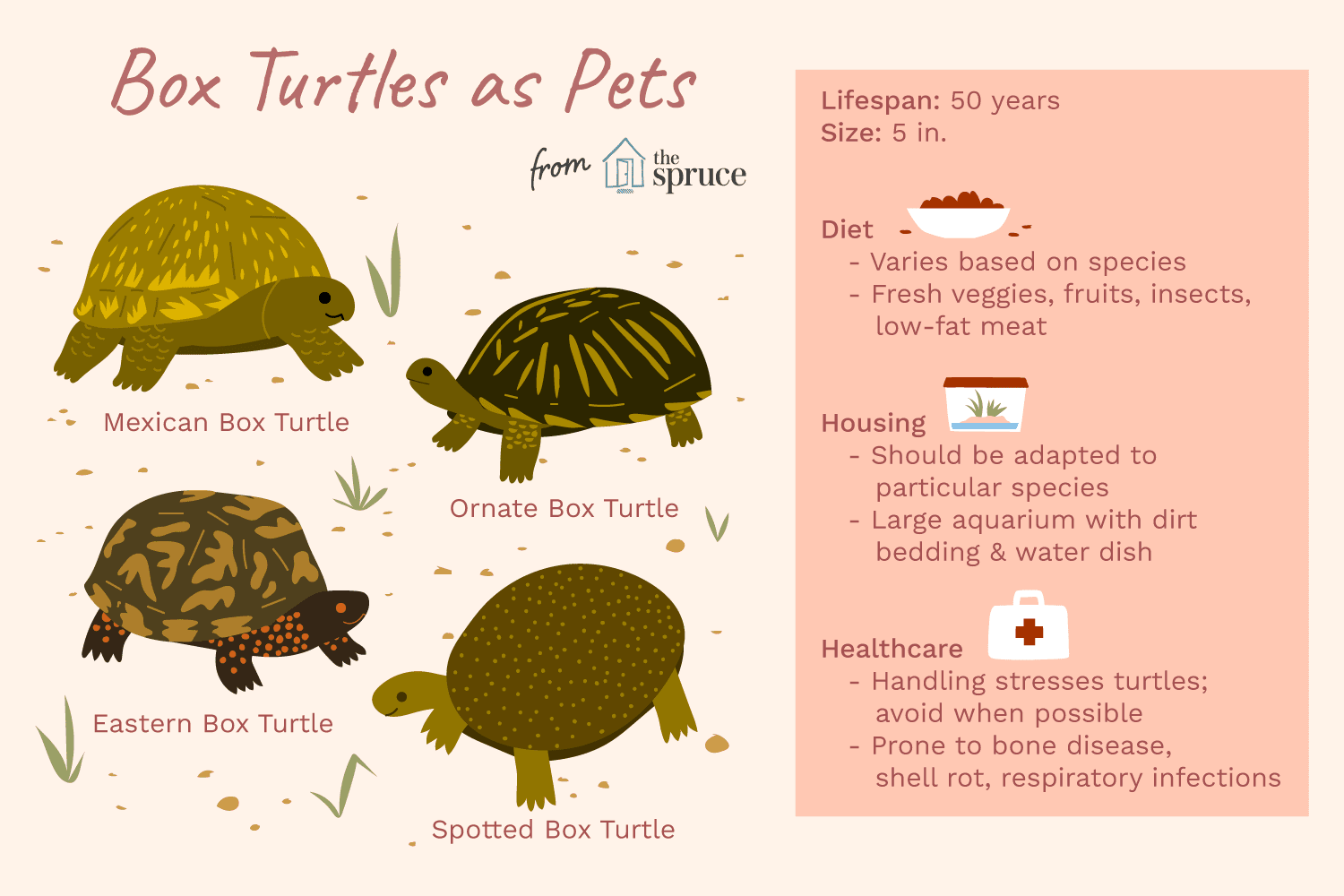To care for a box turtle, provide a spacious enclosure with proper temperature, humidity, and substrate. Offer a varied diet of insects, vegetables, and fruits to ensure balanced nutrition.
Box turtles are fascinating reptiles that make great pets for reptile enthusiasts. Proper care is essential to ensure their health and well-being. In this guide, we will discuss the key aspects of caring for a box turtle, including habitat setup, diet, and general maintenance.
By following these tips, you can create a thriving environment for your box turtle and enjoy their unique characteristics for years to come. Let’s dive in and explore the world of box turtle care together.
Habitat Setup
Box turtles require a well-prepared habitat to thrive in captivity. Setting up the perfect environment is crucial for their health and well-being. The habitat setup for a box turtle includes various aspects such as enclosure selection, substrate, hideouts, temperature, and humidity requirements.
Enclosure Selection
Choose a spacious enclosure with enough room for the box turtle to move around. Ensure the enclosure has secure walls to prevent escapes. Opt for a terrarium or a plastic container with proper ventilation.
Substrate And Hideouts
- Use a substrate like coconut coir or soil to mimic the turtle’s natural habitat.
- Provide hideouts such as half logs or overturned flower pots for the turtle to feel secure.
Temperature And Humidity Requirements
Maintain a temperature of 75-85°F during the day and slightly cooler at night. Humidity levels should be around 60-80%. Use a heat lamp and a UVB light to create a basking spot.
Feeding And Diet
Feeding and diet are crucial factors that contribute to the health and well-being of your box turtle. A proper diet can help your turtle grow and develop properly, while an improper diet can lead to health problems and even death. In this section, we will discuss the ideal diet for box turtles, as well as feeding schedules to ensure they are getting the nutrients they need.
Ideal Diet
Box turtles are omnivores, which means they eat both plants and animals. A balanced diet for a box turtle should consist of:
| Food Group | Examples |
|---|---|
| Protein | Live insects (crickets, mealworms, waxworms), cooked chicken or turkey, canned dog food |
| Fruits | Berries, melons, apples, bananas, grapes, mangoes, papayas |
| Vegetables | Carrots, squash, sweet potatoes, green beans, leafy greens (collard greens, kale, mustard greens), bell peppers |
It is important to offer a variety of foods to ensure your box turtle is getting all the necessary nutrients. Avoid feeding them high-fat or high-sugar foods, as well as toxic foods such as avocado, rhubarb, and chocolate.
Feeding Schedule
A box turtle’s feeding schedule will depend on their age and activity level. Generally, adult box turtles should be fed every other day, while juvenile box turtles should be fed daily. Offer enough food to last for 15-20 minutes and remove any uneaten food to prevent it from spoiling and attracting pests.
It is also important to provide fresh water at all times and to clean their water dish daily. Box turtles may also benefit from a calcium supplement, which can be sprinkled on their food once a week.
By following these guidelines for feeding and diet, you can help ensure your box turtle stays healthy and happy for years to come.
Health And Hygiene
Proper health and hygiene practices are essential for maintaining the well-being of your box turtle. By following a few simple guidelines, you can ensure that your pet remains healthy and happy.
Signs Of Illness
Being attuned to the signs of illness in your box turtle is crucial for prompt intervention. Keep an eye out for symptoms such as lethargy, loss of appetite, abnormal feces, respiratory issues, or any unusual behaviors. If you notice any of these signs, consult a reptile veterinarian immediately.
Regular Cleaning And Maintenance
Implementing a regular cleaning and maintenance routine is vital for your box turtle’s health. This includes cleaning the enclosure, replacing substrate, providing fresh water, and ensuring proper hygiene in their living space. Regularly remove any uneaten food, feces, and soiled substrate to maintain a clean environment.

Credit: www.pinterest.com
Handling And Interaction
Box turtles are fascinating reptiles that can make wonderful pets. When it comes to caring for a box turtle, handling and interaction are essential aspects to consider. Proper handling techniques and creating enriching interactions are crucial for the well-being of these unique creatures.
Proper Handling Techniques
When handling a box turtle, it’s important to ensure that you do so gently and with care. Always approach the turtle calmly and avoid sudden movements that may startle it. Support its body properly, avoiding excessive pressure on its shell, and be mindful of the turtle’s comfort and safety at all times. Wash your hands before and after handling to prevent the spread of bacteria or diseases.
Creating Enriching Interactions
Interacting with your box turtle can be a rewarding experience for both you and the turtle. Providing an enriching environment with varied stimuli such as different textures, hiding spots, and natural elements can help keep your turtle mentally stimulated. Offer occasional supervised outdoor time in a safe, enclosed area to allow your turtle to explore and soak up natural sunlight, which is essential for its health.
Reproduction And Breeding
Box turtles are fascinating creatures, and understanding their reproduction and breeding habits is essential for their well-being. Learning about the breeding season, incubation, and care of hatchlings will help you provide the necessary support for successful reproduction.
Breeding Season
Box turtles typically mate in the spring and early summer, with males actively pursuing females. During this period, it’s crucial to provide a suitable environment with ample space for courtship and mating. Maintaining proper humidity and temperature levels in their habitat can encourage natural breeding behaviors.
Incubation And Care Of Hatchlings
After successful mating, the female box turtle will lay eggs in a suitable nesting site, such as a sandy or loamy area. It’s essential to carefully monitor the nest site to protect the eggs from predators and environmental hazards. Maintaining optimal humidity and temperature during the incubation period is crucial for the development of healthy hatchlings.

Credit: allanspetcenter.com
Common Mistakes To Avoid
When it comes to caring for a box turtle, it’s essential to be aware of the common mistakes that many pet owners make. By understanding these mistakes, you can ensure that your box turtle remains healthy and happy. Here are some common mistakes to avoid when caring for your box turtle:
Overfeeding
Overfeeding can lead to obesity and other health issues in box turtles. It’s important to provide a balanced diet and monitor their food intake to avoid overfeeding. Limit high-fat and high-protein foods, and prioritize leafy greens and vegetables.
Inadequate Temperature Control
Inadequate temperature control can negatively impact a box turtle’s health. Ensure that the enclosure maintains the appropriate temperature range, including a basking area with a temperature of around 85-90°F and a cooler area of 70-75°F. Use a thermometer to monitor the temperature regularly.

Credit: www.boxturtles.com
Conclusion
In caring for a box turtle, remember to provide a suitable habitat with proper heating and lighting. A balanced diet and regular vet check-ups are essential for their well-being. By understanding their needs and creating a nurturing environment, you can ensure a healthy and happy life for your beloved box turtle.






Leave a Reply